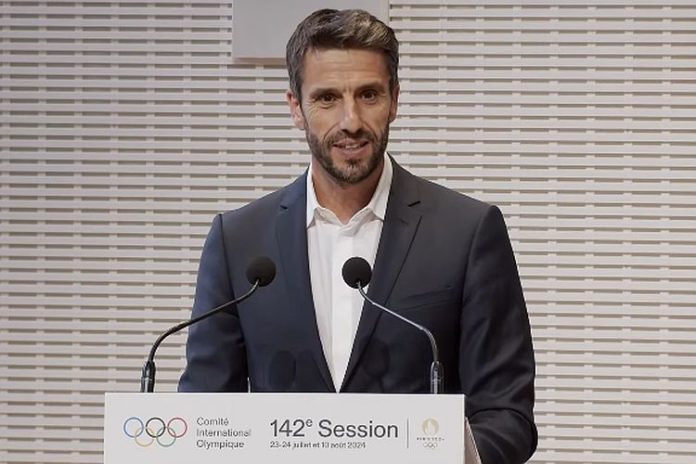★ The Sports Examiner: Chronicling the key competitive, economic and political forces shaping elite sport and the Olympic Movement.★
★ To get the daily Sports Examiner Recap by e-mail: sign up here! ★
≡ COLLEGE REVENUE SHARING ≡
College football is, by several measures, the no. 2 sport in the U.S. and the men’s NCAA Basketball Tournament – “March Madness” – is one of the most popular events in the country, with television rights sales in the billions of dollars.
And that’s where almost all of the money coming from the big sports universities in the Atlantic Coast Conference, Big Ten, Big XII and Southeastern Conference are going to go. Athletes in the money-losing sports such as fencing, golf, gymnastics, swimming, tennis, track & field and wrestling will get next to nothing.
That’s the reality and it’s being talked about openly now. The House vs. NCAA class-action settlement could be approved in April and will bring with it a formula for schools to share revenue with its players. The Bradley law firm note on the case explained:
“[T]he preliminarily approved settlement establishes a 10-year revenue-sharing plan, allowing NCAA conferences and their member schools to share 22% of annual revenue with student-athletes.
“This revenue-sharing plan is permissive, not required. Most importantly, schools can also opt into an athlete pay model of sports revenue, which is capped at $22 million annually for each school (for all athletes in a given school’s athletic program, at the school’s discretion).
“This salary cap is the next step in moving college sports closer and closer to ‘pro-style’ sports, with schools under this model now having to choose where and how to distribute that $22 million figure. The revenue-sharing figure is expected to grow up to $32.9 million by the end of the 10-year revenue-sharing agreement.”
The next question is who gets the money, and the answer has been provided. The Lubbock Avalanche-Journal interviewed Texas Tech Athletic Director Kirby Hocutt and Deputy Director Jonathan Botros in mid-December (Texas Tech is a Big XII school) concerning its projected $20.5 million revenue share:
“Hocutt and deputy AD Jonathan Botros said Tech will distribute about 74% to football players, 17-18% to men’s basketball, 2% to women’s basketball, 1.9% to baseball and smaller percentages to other sports. In dollar amounts, it’s about $15.1 million to football, $3.6 million to men’s basketball and less than $500,000 each to the other teams.”
The “other teams” among Tech’s 17 sports include men’s and women’s cross country and track & field, golf and tennis, and women-only teams in soccer, softball and volleyball. So, two sports will get about 92% and the other 15 – including women’s basketball and men’s baseball – will get 8%.
This is a Title IX lawsuit over discrimination between men’s and women’s programs waiting to happen, and lawyers are already looking into it.
Ross Dellenger of Yahoo! Sports, who has covered this area closely, spoke with the leadership at Ohio State, which has the most athletic revenue in the country at $279.5 million in 2023, about their distribution plans:
● OSU will offer 91 more scholarships than it does now and expects to maintain all 36 of its athletic teams. Of the 91, 58 will be targeted for women, in order to meet Title IX requirements.
● For revenue sharing, the plan is to “stratify” the sports into groups, “presumably tiering them based on their revenue generation as a way to determine for each the allocation of resources, including the portion of athlete-revenue distribution.”
● Athletic Director Ross Bjork said that the distribution would be “proportionally” based, with factors including a “male-female split” and a “market-based approach” using objective indicators such as attendance, viewership on television, social-media traffic and so on.
Dellenger wrote that “For schools offering the maximum $20.5 million of rev-share pool money, the formula means that football rosters would receive $13-16 million and men’s basketball rosters $2-4 million, according to estimates.” That doesn’t leave much.
And if that wasn’t already enough of a problem, Dellenger explained that the projected money for football … is not enough! A school-affiliated, athlete fund-raising collective executive told him:
“If you’re not spending close to $20 million all-in on your football roster, you’re not going to be in the top 20 of schools. That’s where we are trending.
“The trick is, what’s that [House settlement-created] regulatory body going to look like to justify the $7 million for your football roster?”
Dellenger’s story goes on to explain that further fund-raising will be needed specifically to support football, creating valid – as opposed to the current name-image-likeness deals that are really “pay-for-play” payments – corporate and personal sponsorships and name-image-likeness deals that actually have some marketing value.
As much as $3-7 million a year for football alone is projected by some; Dellenger wrote that an SEC-school collective official told him, “We already do $2 million in real deals. We can maybe push it to $4 million.”
¶
The Texas Tech mission statement reads:
“As a public research university, Texas Tech advances knowledge through innovative and creative teaching, research and scholarship. The university is dedicated to student success by preparing learners to be ethical leaders for a diverse and globally competitive workforce. The university is committed to enhancing the cultural and economic development of the state, nation and world.”
The Ohio State University mission statement:
“The university is dedicated to:
“● Creating and discovering knowledge to improve the well-being of our local, state, regional, national and global communities;
“● Educating students through a comprehensive array of distinguished academic programs;
“● Preparing a diverse student body to be leaders and engaged citizens;
“● Fostering a culture of engagement and service.
“We understand that diversity and inclusion are essential components of our excellence.”
Neither speaks to fielding professional football or basketball teams, or athletic programs of any kind. We now have a tail wagging the dog, so to speak, at least at Texas Tech, where the university is spending $14.71 million to support athletics in institutional operating funds and debt service. Does that support its mission? Ohio State says its athletics program does not receive taxpayer funding.
What started as extra-curricular activities more than a century ago have now become, for football and men’s basketball, professional sports teams. This is a problem for the universities themselves, and only the universities themselves can solve it.
The Sports Examiner has shared its own solution, back in April, but the House vs. NCAA settlement – whose name plaintiff, Grant House, was an Arizona State swimmer – will only concentrate collegiate sport into football, basketball and some leftovers.
LA28 Olympic and Paralympic organizing committee Chair Casey Wasserman said in a December forum:
“You add $20 million of expense to the athletic department. What’s the first thing you cut? … Olympic sports, non-revenue sports. You cut the sports that cost money that don’t generate revenue.
“A lot of schools will hang in, not just in California, but in the country, until 2028, until the games are in L.A. And after that, you’re going to see a lot more schools have SEC numbers of teams than former Pac-12 numbers of teams. The days of 25 and 30 teams are over. So now you’re going to have 15 to 17.”
The NCAA’s statistical overview of sports sponsored on campuses shows that the average number of teams at Division I schools has increased only marginally since women’s sports were added in 1981-82: from an average of 17.5 to 19.1. That’s it. And in 1981-82, that was roughly 10 men’s teams and seven women’s teams. Today, it’s 8.5 men’s teams on average and 10.6 women’s teams. And with the House settlement, the numbers are going to go down.
This problem is a challenge not to athletes, coaches or athletic departments. The NCAA is, in reality, the university presidents, and they have to fix this. That assumes they want to; two more numbers to indicate how small an issue athletics may really be:
● Ohio State’s overall, fiscal 2025 budget includes $9.9 billion in spending.
● Texas Tech’s overall, fiscal 2025 budget includes $3.1 billion in spending.
Do school presidents really care about the cost of athletics? Only 46 schools had athletics costs of $100 million or more in 2023 and another 21 spent $50 million or more, all at billion-dollar, major universities.
Who cares is the issue and if the schools don’t, the President and the Congress might. And what happens then?
Rich Perelman
Editor
★ Receive our exclusive, weekday TSX Recap by e-mail by clicking here.
★ Sign up a friend to receive the TSX Recap by clicking here.
★ Please consider a donation here to keep this site going.
For our updated, 895-event International Sports Calendar for 2025 and beyond, by date and by sport, click here!


























